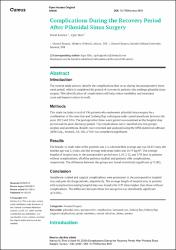Complications During the Recovery Period After Pilonidal Sinus Surgery
Abstract
Introduction: The current study aims to identify the complications that occur during the postoperative three-week period, which is considered the period of recovery in patients who undergo pilonidal sinus surgery. This identification of complications will help reduce morbidity and treatment costs and improve return to work.
Methods: This study included a total of 196 patients who underwent pilonidal sinus surgery by a combination of the resection and Limberg flap techniques under spinal anesthesia between the years 2012 and 2016. The postoperative three-week period was examined as the hospital stay period and the post-discharge period. The complications were classified into two groups: surgical and anesthesia. Results were recorded and analyzed using the SPSS statistical software (IBM Corp., Armonk, NY, US). p<0.05 was considered significant.
Results: The female-to-male ratio of the patients was 1:4, whereas their average age was 24.15 years, the median age was 22 years, and the average body mass index was 24.79 kg/m(2). The average lengths of hospital stay in the postoperative period were 1.10, 2.15, and 3.95 days in patients without complications, all of the patients studied, and patients with complications, respectively. The difference between the groups was found statistically significant (p<0.001).
Conclusion: Anesthesia-related and surgical complications were prominent in the postoperative hospital stay and post-discharge periods, respectively. The average length of hospital stay in patients with complications during hospital stay was found to be 3.59 times higher than those without complications. The difference between these two categories was statistically significant (p<0.001).
Volume
11Issue
4Collections
The following license files are associated with this item:


















